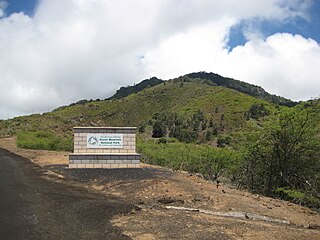
Green Mountain is a common name for "The Peak", the highest point and a stratovolcano on Ascension Island, which has gained some fame for claims that it is one of very few large-scale artificial forests. Green Mountain is ranked 38th by topographic isolation.

The Saint Helena olive is an extinct species of flowering plant. It is the only member of the genus Nesiota. It was endemic to the island of Saint Helena in the South Atlantic Ocean. Despite its name, it is unrelated to the true olive, but is instead a member of the family Rhamnaceae, the family which contains buckthorns and jujube. The last remaining tree in the wild died in 1994, and the last remaining individual in cultivation died in December 2003, despite conservation efforts. It is thus a prime example of recent plant extinction. The Saint Helena olive belongs to the tribe Phyliceae, which are mostly endemic to Southern Africa.
Lachanodes arborea, the she cabbage tree, is a small tree in the family Asteraceae. It is an endangered endemic of the island of Saint Helena in the South Atlantic Ocean. It is now extinct in the wild.
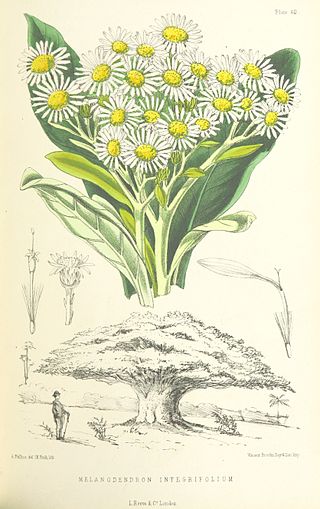
Melanodendron is a genus of trees in the family Asteraceae, with only one species, Melanodendron integrifolium, native to the island of Saint Helena. It is related to the Saint Helenan gumwoods and is the most common of the remaining cabbage tree species of Saint Helena, although it is considered endangered due to the restricted population size.

Acalypha rubrinervis is an extinct plant in the spurge family (Euphorbiaceae), from the island of Saint Helena in the South Atlantic Ocean. It was called string tree on account of the thin pendulous inflorescences which resembled red strings. Disturbance following human settlement on the island destroyed its habitat and it was last seen in the 19th century. It is thus one of a number of island plants to have been driven to extinction by human activity.
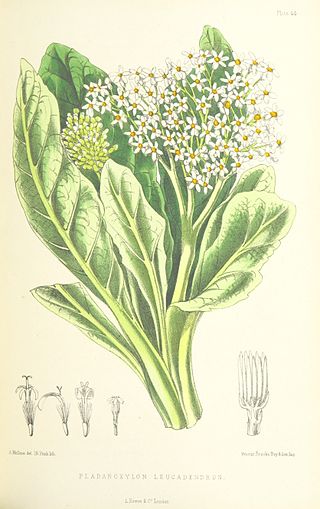
Pladaroxylon is a genus of trees in the tribe Senecioneae within the family Asteraceae.
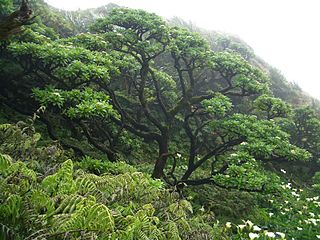
The flora of Saint Helena, an isolated island in the South Atlantic Ocean, is exceptional in its high level of endemism and the severe threats facing the survival of the flora. In phytogeography, it is in the phytochorion St. Helena and Ascension Region of the African Subkingdom, in the Paleotropical Kingdom.

Trochetiopsis erythroxylon, the Saint Helena redwood, is a species of plant, now extinct in the wild. It was formerly abundant enough in the upland parts of the island of Saint Helena for early settlers in the 17th century to use the timber to make their homes. It became extinct in the 1950's due to deforestation as its habitat was cleared to make way for pasture, timber and fuel.

Trochetiopsis ebenus, the dwarf ebony or Saint Helena ebony, is a species of flowering plant that is endemic to the island of Saint Helena in the southern Atlantic Ocean. It is not related to the ebony of commerce, but is instead a member of the mallow family, Malvaceae. Saint Helena ebony is now critically endangered in the wild, being reduced to two wild individuals on a cliff, but old roots are sometimes found washed out of eroding slopes. These are collected on the island a used for inlay work, an important craft on Saint Helena. A related species, Trochetiopsis melanoxylon is now completely extinct.

Commidendrum robustum, the Saint Helena gumwood, is a species of tree endemic to Saint Helena, Ascension and Tristan da Cunha. Though it is now comparatively rare, it was once one of the most abundant trees of mid-elevations of the island of Saint Helena in the South Atlantic Ocean. A small tree to 7–8 m, it was cut extensively for fuel in the early years of settlement of the island by the English East India Company. It has given its name to certain placenames on the island such as "Gumwoods". It is one of several species in the endemic genus Commidendrum.
Saint Helena, Ascension Island and Tristan da Cunha, as well the other uninhabited islands nearby, are a haven for wildlife in the middle of the Atlantic Ocean. The islands are or were home to much endemic flora and fauna, especially invertebrates, and many endemic fish species are found in the reef ecosystems off the islands. The islands have been identified by BirdLife International as Important Bird Areas for both their endemic landbirds and breeding seabirds.

The Saint Helena plover, locally known as the wirebird due to its thin legs, is a small wader endemic to the island of Saint Helena in the mid-Atlantic. The bird is similar in appearance to Kittlitz's plover and the Madagascar plover, but a little larger and an absence of chamois coloring. It is the national bird of St Helena and has been depicted on the country's coins. Populations in general have been declining. Threats include predation by cats, the introduction of the common myna, deforestation, off-road vehicle use, the Saint Helena Airport and a projected windfarm. In 2016, the population had recovered to about 560 mature individuals, from a previous minimum of less than 200 in 2006; consequently, the species was downlisted to Vulnerable from its previous assessment of Critically Endangered.

Frankenia portulacifolia, also called Saint Helena tea or tea plant, is a species of salt-tolerant plant in the Frankeniaceae family. It is endemic to the islands of Saint Helena, Ascension and Tristan da Cunha. Its natural habitats are inhospitable, dry and rocky areas and rocky shores, often on weathered volcanic ash. As its total population has been estimated at only around 3,500 individuals, it is currently classified as Critically Endangered by the IUCN.
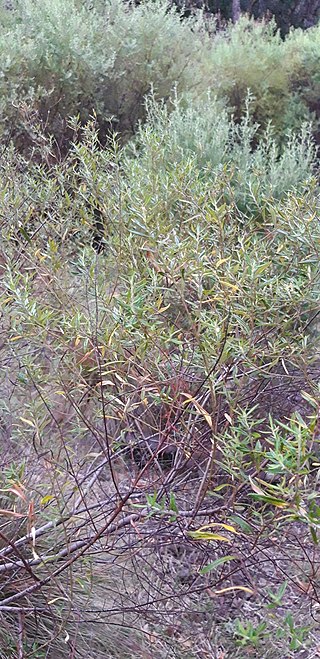
Phylica polifolia, also called rosemary or Saint Helena rosemary, is a species of plant in the family Rhamnaceae. It is endemic to Saint Helena. Its natural habitats are rocky areas and rocky shores.
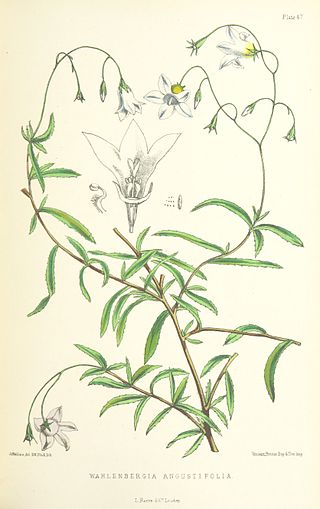
Wahlenbergia angustifolia, also called small bellflower, is a species of plant in the family Campanulaceae. It is endemic to Saint Helena. Its natural habitat is rocky areas. It is endangered because of habitat loss.

Prosperous Bay Plain is an area on the eastern coast of Saint Helena, a British island territory in the South Atlantic Ocean. It is the site of the Saint Helena Airport, and is notable for its high invertebrate biodiversity.

Bulbostylis neglecta, neglected tuft sedge locally, is an endemic member of the Cyperaceae of Saint Helena in the South Atlantic.
The South Atlantic Invasive Species Project is a three-year project funded under the European Union EDF 9. The purpose of the project is to increase the capacity of the UK's South Atlantic Overseas Territories to deal with invasive species issues. The territories involved are Saint Helena, Tristan da Cunha, South Georgia and the South Sandwich Islands, the Falkland Islands and Ascension Island. The project is managed by the Royal Society for the Protection of Birds (RSPB) on behalf of the partner governments. In addition to the partner governments, two NGOs: Falklands Conservation and the Saint Helena National Trust are key stakeholders.
Asplenium haughtonii, also known as the Barn fern, is a species of fern in the family Aspleniaceae. It is native to Saint Helena.
Eragrostis episcopulus, the cliff hair grass, is a species of grass endemic to St. Helena. The species is classified as Critically Endangered because of its extremely restricted range and population fragmentation.















